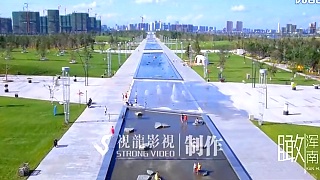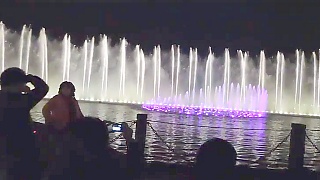
|
ShangHai: 20 Kid-Friendly Places to Visit
Shanghai Disneyland (上海迪士尼乐园 Shànghǎi Díshìní Lèyuán): Enjoy magical attractions and meet Disney characters at this theme park.
Ocean Aquarium (上海海洋水族馆 Shànghǎi Hǎiyáng Shuǐzúguǎn): Explore marine life exhibits and interactive displays.
Century Park (世纪公园 Shìjì Gōngyuán): Relax in green spaces and enjoy boating on the lake in this expansive park.
Shanghai Natural History Museum (上海自然博物馆 Shànghǎi Zìrán Bówùguǎn): Learn about dinosaurs, fossils, and natural history.
Shanghai Science and Technology Museum (上海科技馆 Shànghǎi Kējìguǎn): Discover interactive exhibits on science and technology.
Shanghai Zoo (上海动物园 Shànghǎi Dòngwùyuán): Visit pandas, monkeys, and other animals in this popular zoo.
Shanghai Children's Museum (上海儿童博物馆 Shànghǎi Értóng Bówùguǎn): Interactive museum with exhibits designed for children.
Happy Valley Shanghai (上海欢乐谷 Shànghǎi Huānlègǔ): Amusement park with thrilling rides and entertainment.
Shanghai Ocean Aquarium (上海海洋水族馆 Shànghǎi Hǎiyáng Shuǐzúguǎn): Explore marine life exhibits and interactive displays.
Shanghai Changfeng Ocean World (上海长风海洋世界 Shànghǎi Chángfēng Hǎiyáng Shìjiè): Enjoy a variety of aquatic attractions and shows.
Shanghai Botanical Garden (上海植物园 Shànghǎi Zhíwùyuán): Explore diverse plant collections and enjoy outdoor activities.
Shanghai Circus World (上海马戏城 Shànghǎi Mǎxì Chéng): Watch acrobatic performances and circus acts.
Shanghai Disney Store (上海迪士尼商店 Shànghǎi Díshìní Shāngdiàn): Shop for Disney merchandise and souvenirs.
Shanghai Natural Wild-Insect Kingdom (上海自然野生昆虫馆 Shànghǎi Zìrán Yěshēng Kūnchóngguǎn): Learn about insects and their habitats.
Shanghai Haichang Ocean Park (上海海昌海洋公园 Shànghǎi Hǎichāng Hǎiyáng Gōngyuán): Enjoy marine-themed attractions and shows.
Shanghai Madame Tussauds (上海杜莎夫人蜡像馆 Shànghǎi Dùshā Fūrén Làxiàngguǎn): Pose with lifelike wax figures of celebrities.
Shanghai Happy Valley (上海欢乐谷 Shànghǎi Huānlègǔ): Amusement park with thrilling rides and entertainment.
Shanghai Film Park (上海电影公园 Shànghǎi Diànyǐng Gōngyuán): Explore film sets and learn about movie production.
Shanghai Changfeng Park (上海长风公园 Shànghǎi Chángfēng Gōngyuán): Enjoy green spaces and outdoor activities.
Shanghai Changfeng Ocean World (上海长风海洋世界 Shànghǎi Chángfēng Hǎiyáng Shìjiè): Enjoy a variety of aquatic attractions and shows.
ShangHai: 30 More Places to Visit
The Bund (外滩 Wàitān): Enjoy iconic skyline views and colonial architecture along the Huangpu River.
Yu Garden (豫园 Yù Yuán): Explore classical Chinese gardens and traditional architecture.
Shanghai Tower (上海中心大厦 Shànghǎi Zhōngxīn Dàshà): Visit one of the tallest buildings in the world for breathtaking views.
Nanjing Road (南京路 Nánjīng Lù): Shop for souvenirs, fashion, and electronics on this bustling shopping street.
Jin Mao Tower (金茂大厦 Jīn Mào Dàshà): Visit this skyscraper for observation decks and a luxurious hotel.
Shanghai World Financial Center (上海环球金融中心 Shànghǎi Huánqiú Jīnróng Zhōngxīn): Enjoy panoramic views from the Skywalk Observatory.
Shanghai Museum (上海博物馆 Shànghǎi Bówùguǎn): Explore Chinese art and artifacts in this renowned museum.
Tianzifang (田子坊 Tiánzǐ Fāng): Wander through narrow alleys filled with shops, galleries, and cafes.
Power Station of Art (上海当代艺术博物馆 Shànghǎi Dāngdài Yìshù Bówùguǎn): Explore contemporary art exhibitions in a former power station.
Shanghai Urban Planning Exhibition Center (上海城市规划展示馆 Shànghǎi Chéngshì Guīhuà Zhǎnshì Guǎn): Learn about the development of Shanghai through interactive exhibits.
Shanghai French Concession (上海法租界 Shànghǎi Fǎ Zūjiè): Explore leafy streets, historic buildings, and trendy boutiques.
Longhua Temple (龙华寺 Lónghuá Sì): Visit one of the oldest and largest Buddhist temples in Shanghai.
Zhujiajiao Water Town (朱家角 Zhūjiājiǎo): Explore ancient canals, bridges, and traditional architecture in this historic water town.
Xintiandi (新天地 Xīntiāndì): Shop, dine, and explore entertainment venues in this renovated historic area.
Huangpu River Cruise (黄浦江游船 Huángpǔ Jiāng Yóuchuán): Enjoy scenic views of Shanghai's skyline from the river.
Shanghai Tower (上海中心大厦 Shànghǎi Zhōngxīn Dàshà): Visit one of the tallest buildings in the world for breathtaking views.
Nanjing Road (南京路 Nánjīng Lù): Shop for souvenirs, fashion, and electronics on this bustling shopping street.
Jin Mao Tower (金茂大厦 Jīn Mào Dàshà): Visit this skyscraper for observation decks and a luxurious hotel.
Shanghai World Financial Center (上海环球金融中心 Shànghǎi Huánqiú Jīnróng Zhōngxīn): Enjoy panoramic views from the Skywalk Observatory.
Shanghai Museum (上海博物馆 Shànghǎi Bówùguǎn): Explore Chinese art and artifacts in this renowned museum.
Tianzifang (田子坊 Tiánzǐ Fāng): Wander through narrow alleys filled with shops, galleries, and cafes.
Power Station of Art (上海当代艺术博物馆 Shànghǎi Dāngdài Yìshù Bówùguǎn): Explore contemporary art exhibitions in a former power station.
Shanghai Urban Planning Exhibition Center (上海城市规划展示馆 Shànghǎi Chéngshì Guīhuà Zhǎnshì Guǎn): Learn about the development of Shanghai through interactive exhibits.
Shanghai French Concession (上海法租界 Shànghǎi Fǎ Zūjiè): Explore leafy streets, historic buildings, and trendy boutiques.
Longhua Temple (龙华寺 Lónghuá Sì): Visit one of the oldest and largest Buddhist temples in Shanghai.
Zhujiajiao Water Town (朱家角 Zhūjiājiǎo): Explore ancient canals, bridges, and traditional architecture in this historic water town.
Xintiandi (新天地 Xīntiāndì): Shop, dine, and explore entertainment venues in this renovated historic area.
Huangpu River Cruise (黄浦江游船 Huángpǔ Jiāng Yóuchuán): Enjoy scenic views of Shanghai's skyline from the river.
|

 A trip to TongLi 同理, SuZhou
A trip to TongLi 同理, SuZhou





